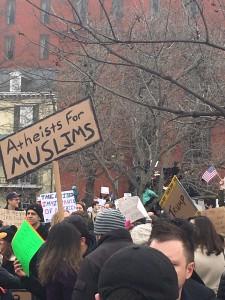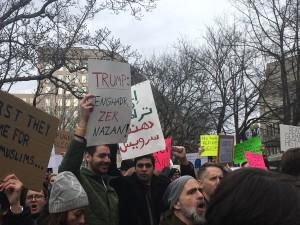
Protesters rallied in front of the White House before marching down Pennsylvania Ave. toward the Capitol to protest President Donald Trump’s executive order on immigration.
In response to President Donald Trump’s executive order banning entry into the United States to citizens from seven Muslim-majority countries, hundreds of protesters stood outside the White House for hours yesterday before walking down Pennsylvania Ave. to the Capitol building.
Seven predominantly Muslim countries — Syria, Yemen, Sudan, Somalia, Iraq, Iran and Libya — had immigration to the United States indefinitely suspended. Protesters across the country gathered at airports and in U.S. cities to demonstrate against the order.
The executive order signed Jan. 27, Protecting the Nation from Foreign Terrorist Entry Into the United States and mandates the halt of refugees entering the country for the next 120 days, with an exception banning Syrian refugees indefinitely.
Today, federal judges from at least four cities released provisional court orders, which deemed Trump’s move too hasty, marking preliminary checks on the executive branch from the judicial branch.
Standing on the grass of Lafayette Square in front of the White House, Ammarah Iqbal, an American-born daughter of Iranian immigrants, said she was protesting the ban in solidarity with those directly affected.
“I’m here because I want to join forces and I feel very strongly about this ban. I feel blessed to be here with all these people who also feel the same way,” Iqbal said. “This is home.”
Kendall Silwonuk (COL ’19), who attended the march, said she did not understand how an executive order from the president could selectively exclude certain people from entering the country, which many call home.
“Yesterday, I had a pretty rough day after I found out about the ban. It just bothers me that we can classify a whole group of countries as not allowed to be here,” Silwonuk said. “It gives people a reason to not like the United States.”
While she believes in the power of protests, Silwonuk said she worries protesting will become the new normal without substantial policy change to accompany it.
“I did see a girl whose sign said ‘Protesting is the new brunch’ and it hit me then that it’s possible there will be a reason to be out there every weekend. That’s scary, that next weekend, we might have to do this again because it’s not going to change,” Silwonuk said. “Her sign was funny at first and then I was like, wait a second, that’s our new reality.”

According to Silwonuk, the protest was a peaceful demonstration of solidarity across genders, race, religion and age.
“My favorite part was there were a lot of kids,” Silwonuk said. “It was cool that parents felt comfortable enough to bring their kids but also inspired enough to get them involved in activism so young. People believe in a peaceful protest that way. It was very hopeful I thought.”
Jeanne Chatellet was one mother who brought her children to the protest. Chatellet said she wanted her three kids to understand that the United States is not a country of hate.
“I wanted to teach them that America is an inclusive country. We welcome everybody, and it’s not right to exclude people on the basis of religion and their country,” Chatellet said. “I want them to grow up being tolerant and open to other cultures and faiths.”




















